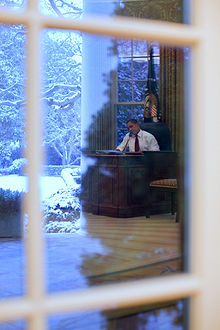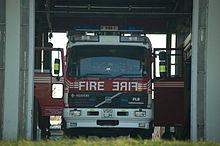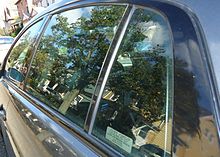- Mirror image
-
For other uses, see Mirror image (disambiguation).
 Window reflection. U.S. President Barack Obama in the Oval Office 1/27/09. Official White House photo by Pete Souza.
Window reflection. U.S. President Barack Obama in the Oval Office 1/27/09. Official White House photo by Pete Souza.
A mirror image is a reflected duplication of an object that appears identical but reversed. As an optical effect it results from reflection off of substances such as a mirror or water. It is also a concept in geometry and can be used as a conceptualization process for 3-D structures. In chemistry, a '"mirror image'" is a molecule having a spatial arrangement that corresponds to that of another molecule except that the right-to-left sense on one corresponds to the left-to-right sense on the other, the left handedness being known as "levo" or l-x and the righthandedness being known as "dextro" or d-x, where "x" is the referenced molecule.
Contents
In geometry
In two dimensions
In geometry, the mirror image of an object or two-dimensional figure is the virtual image formed by reflection in a plane mirror; it is of the same size as the original object, yet different, unless the object or figure has reflection symmetry (also known as a P-symmetry).
Two-dimensional mirror images can be seen in the reflections of mirrors or other reflecting surfaces, or on a printed surface seen inside out.
In three dimensions
The concept of mirror image can be extended to three-dimensional objects, including the inside parts, even if they are not transparent. The term then relates to structural as well as visual aspects. This is also called enantiomer or enantiomorph.
If a point of an object has coordinates (x, y,z) then the image of this point (as reflected from the mirror in y, z plane) has coordinates (-x, y,z) - so mirror reflection is a reversal of the coordinate axis perpendicular to the mirror's surface. Thus, a mirror image does not have reversed right and left (or up and down), but rather reversed front and back. The left-right reversal of the mirror image only holds in relation a normal (i.e. unreflected) picture that we see in front of us; see schematic illustration at the right. For instance, if we look at a picture or object in our hand and then turn it towards a mirror, the picture and thus its mirror reflection have made a left-to-right 'flip over' of 180 degrees. The same principle holds when we stand with our back towards the mirror and face a picture or object in front of the mirror, and then compare it with its reflection by turning our head or body 180 degrees towards the mirror. It is thus not the mirror itself, but our own relative position and viewing point that has caused the apparent left-to-right reversal.
A mirror image appears three-dimensional if the observer moves. This is because the relative position of objects changes as the observer's perspective changes.[1]
Looking through a mirror from different positions (but necessarily with the point of observation restricted to the halfspace on one side of the mirror) is like looking at the 3D mirror image of space; without further mirrors only the mirror image of the halfspace before the mirror is relevant; if there is another mirror, the mirror image of the other halfspace is too.
Uses
 The word fire and its mirror image are displayed on the front of this fire engine
The word fire and its mirror image are displayed on the front of this fire engine
A text is sometimes deliberately displayed in mirror image, in order to be read through a mirror. Emergency vehicles such as ambulances or fire engines use mirror images in order to be read from a driver's rear-view mirror. Some movie theaters also use a Rear Window Captioning System to assist individuals with hearing impairments watching the film.
Systems of mirrors
In the case of two mirrors, in planes at an angle α, looking through both from the sector which is the intersection of the two halfspaces, is like looking at a version of the world rotated by an angle of 2α; the points of observations and directions of looking for which this applies correspond to those for looking through a frame like that of the first mirror, and a frame at the mirror image with respect to the first plane, of the second mirror. If the mirrors have vertical edges then the left edge of the field of view is the plane through the right edge of the first mirror and the edge of the second mirror which is on the right when looked at directly, but on the left in the mirror image.
In the case of two parallel mirrors, looking through both once is like looking at a version of the world which is translated by twice the distance between the mirrors, in the direction perpendicular to them, away from the observer. Since the plane of the mirror in which one looks directly is beyond that of the other mirror, one always looks at an oblique angle, and the translation just mentioned has not only a component away from the observer, but also one in a perpendicular direction. The translated view can also be described by a translation of the observer in opposite direction. For example, with a vertical periscope, the shift of the world is away from the observer and down, both by the length of the periscope, but it is more practical to consider the equivalent shift of the observer: up, and backward.
See also
References
- ^ Adams, Cecil (1985-09-27). "Are dogs unable to see 2-D images (mirrors, photos, TV)?". The Straight Dope. http://www.straightdope.com/classics/a2_071b.html. Retrieved 2008-01-31.
External links
Categories:- Elementary geometry
- Chirality
Wikimedia Foundation. 2010.


